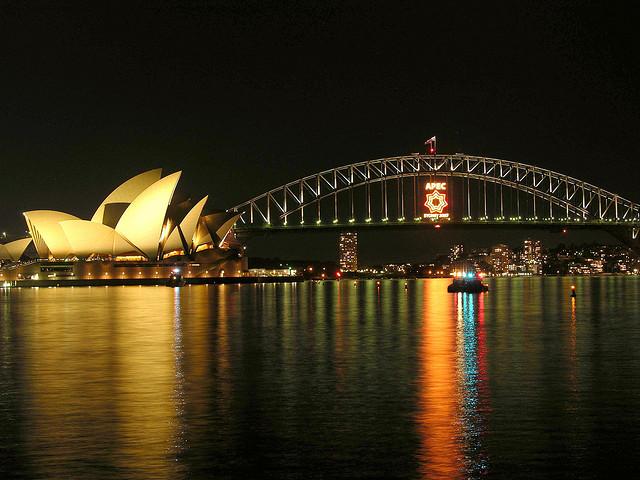Oz–India geoeconomics
Posted By Graeme Dobell on September 14, 2015 @ 06:00
If we wait for Australia and India to develop a common regional vision, we’ll wait forever. Some things will never happen. At least, though, the astigmatism that’s long afflicted the Oz–India ‘views’ of each other is improving. Granted some of this is the bounce you get from a low base, but the Oz–India trend line is positive: interests start to align, policies touch, priorities rhyme.
India aspires to be a leader, not just a balancer. Narendra Modi looks for new partners and lots of countries are eager to play. An India with a broader view will find it easier to fit Australia into the frame.
The geostrategic music swells—although (that low base thought) it’s easy to improve on past periods of Oz–India silence. Equally—and even more loudly— trade trends shift the geoeconomic understandings of India and Australia. In the circular way of these things, economic changes feed directly into the geostrategic vision of the Indo–Pacific now loudly proclaimed by Canberra.
The goal of finalising a Comprehensive Economic Cooperation Agreement (CECA) between Australian and India by the end of 2015 is being talked up as a major opportunity for the two economies.
Canberra wants a re-run of the magic that China has sprinkled on the Australian economy. That profound shift means that in the 21st century, Australia has been de-coupled from two US economic downturns; US recession no longer automatically infects Australia as it did in the 20th century. Australia’s economic fate is tied to Asia—China today, India tomorrow.
The Trade Minister, Andrew Robb, says Australia and India [2] are:
‘On the cusp of a new dawn in their commercial relationship…There is something special going on in India. The enormous vision of Prime Minister Modi has excited many people. Australia is looking forward to being a part of this very important period in India’s re-emergence as a significant power.’
Boosterism is always at a discount in trade negotiations. Yet the way Australia and India are prepared to contemplate each other speaks to that hope about the frame widening and the vision clearing.
Trade and economic interests are not always definitive, but they have obvious weight and—most importantly—influence the hierarchy and slow re-ordering of national preferences. The shift of economic weight has cumulative effects on preferences which feed into judgements about national interest.
What were once easy options can become unthinkable or at least look narrow and outdated because of these cumulative changes. This is not soft power influence, but the hard power calculations of dollars and cents.
On what was once barely considered and now looks distinctly odd, consider how Australian thinking about China and India has shifted over 25 years, using the frame offered by APEC.
In 1989, Australia helped create the key governmental instrument for the Asia–Pacific’s economic future while not having China as a founding member. Yep, folks, the first post-Cold War expression of the Asia–Pacific didn’t include China! Extraordinary now, necessary then if not necessarily logical: the horror of the Tiananmen massacre meant China couldn’t be in APEC at its founding. And when, a few years later, Beijing did join, it had to walk through the door together with two other ‘economies’—Taiwan and Hong Kong. Such equivalence is today unimaginable, not least because back then Beijing was prepared to swallow it.
Introducing India makes this walk through recent history even stranger—because the strangeness persists. When APEC was being created, India was far from the threshold of membership.
As India surged, the threshold kept retreating.
Australia, as much as anybody, imposed the ten year freeze on new APEC members—read India—in 1997. And a decade later, Australia, as APEC chairman, wouldn’t or couldn’t push for India’s membership. The Howard Government said there was no regional consensus on India joining. Following Howard, Kevin Rudd pledged support for India’s APEC membership but nothing much moved. The pity is that the chances for Australia to matter on this were back when it mattered—in 1997 or 2007.
Australia’s approach reflected the blurred-vision history on India. The Howard Government worried about India’s commitment to the APEC core mantra of ‘open regionalism’ while blocking India from the open-regionalism worship group.
India is still out—although not for much longer—because now APEC is the loser. Australia was guilty of a failure of imagination and leadership when it chaired APEC in 2007 for not crusading on India’s behalf. Back then, China, particularly was quite happy with the existing membership, while ASEAN was more interested in India’s role in the East Asia Summit. Australia didn’t push for India in APEC membership when it had the chair.
What is a glaring gap in the APEC lineup is about to be fixed, more than two decades after India first tried and failed to get into the grouping. The APEC summit in Manila this year is set to admit India [3] to the club [4].
If we were creating APEC from scratch today, both China and India would be so essential as to wield a veto. That statement of the obvious drives much else in Australia’s enlarged and clearer view of India.
Article printed from The Strategist: https://aspistrategist.ru
URL to article: /oz-india-geoeconomics/
URLs in this post:
[1] Image: https://aspistrategist.ru/wp-content/uploads/2015/09/1351802695_3e6fac7f36_z.jpg
[2] , says Australia and India: http://trademinister.gov.au/releases/Pages/2015/ar_mr_150116.aspx
[3] set to admit India: http://timesofindia.indiatimes.com/business/india-business/Asia-Pacific-Economic-Cooperation-to-consider-Indias-membership-request/articleshow/48857467.cms
[4] the club: http://timesofindia.indiatimes.com/business/india-business/India-ready-to-join-Apec-US-to-help/articleshow/46024577.cms
Click here to print.
